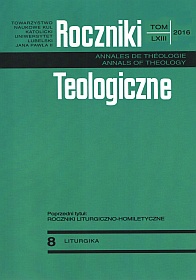Eucharist between History and Echatology
Abstract
The article presents a model of eschatology in the light of the history of Salvation, in which the parousia is seen not only as the ultimate coming of Jesus Christ but also as “revelation— ἀποκάλυψις [apokalypsis]” and “epiphany—ἐπιφάνεια [epiphaneia].” This model of eschatology is derived from the Divine Revelation present in the Holy Bible and allows us to comprehend the eschatology of the apostolic era in the proper manner as Eucharistic eschatology. The paradigm for this eschatology is St Stephen’s vision of Christ during his martyr’s death (Acts 7:55–56). The best example of Eucharistic eschatology is the Gospel of St Luke, where the Eucharist is firmly tied with the reality of the Kingdom of God. After Christ’s resurrection each Eucharist constitutes participation in the eschatological feast in which the Master of Heaven and Earth serves the participants and gives Himself as nourishment. The very eternity is the Eucharist fulfilled.
References
Bartnik Cz.S.: Dogmatyka katolicka, t. 2, Lublin: Wydawnictwo KUL 2003.
Benedykt XVI: Adhortacja apostolska Sacramentum caritatis, Kraków: Wydawnictwo św. Stanisława BM 2007.
Corbon J.: Liturgia źródło wody życia, przeł. A. Foltańska, Poznań: W drodze 2005.
Daley B.: The Hope of the Early Church. A Handbook of Patristic Eschatology, Peabody, MA): Hendrickson 2003.
De Vaux R.: Instytucje Starego Testamentu, przeł. T. Brzegowy, Poznań: Pallottinum 2004.
Dix G.: The Shape of the Liturgy, New York: Seabury 1982.
Ewangelia wg. św. Łukasza. Wstęp – przekład z oryginału – komentarz, oprac. F. Gryglewicz, Poznań–Warszawa: Pallottinum 1974.
Gros J.: The Roman Catholic View, w: The Lord’s Sapper. Five Views, red. G.T. Smith, Downers Grove, IL: InterVarsity Press Academic 2008, s. 13-27.
Hahn S.: Moc Słowa w liturgii. Od tekstu pisanego do żywego słowa liturgii, przeł. P. Blumczyński, Kraków: Wydawnictwo „Salwator” 2010.
Jankowski A.: Eschatologia Nowego Testamentu, Kraków: Wydawnictwo WAM 20072.
Kereszty R.A.: Wedding Feast of the Lamb. Eucharistic Theology from a Historical, Biblical, and Systematic Perspective, Chicago/Mundelein, IL: Hillenbrand Books 2004.
Kudasiewicz J.: Teksty ustanowienia Eucharystii, w: Biblia o Eucharystii, red. S. Szymik, Lublin: RW KUL 1997, s. 63-82.
Pelikan J.: Powstanie wspólnej tradycji (100-600), przeł. M. Höffner, Kraków: Wydawnictwo Uniwersytetu Jagiellońskiego 2008.
Ratzinger J.: Duch liturgii, w: Teologia liturgii. Sakramentalne podstawy życia chrześcijańskiego, (Opera omnia, t. XI), red. K. Góźdź, M. Górecka, Lublin: Wydawnictwo KUL 2012, s. 23-182.
Ratzinger J.: Kościół i liturgia, w: Kościół – znak wśród narodów. Pisma eklezjologiczne i ekumeniczne, (Opera omnia, t. VIII/1), red. K. Góźdź, M. Górecka, Lublin: Wydawnictwo KUL 2012, s. 143-162.
Schmemann A.: Eucharystia. Misterium Królestwa, przeł. A. Andrzej Turczyński, Białystok: Orthdruk 1997.
Copyright (c) 2016 Roczniki Teologiczne

This work is licensed under a Creative Commons Attribution-NonCommercial-NoDerivatives 4.0 International License.





